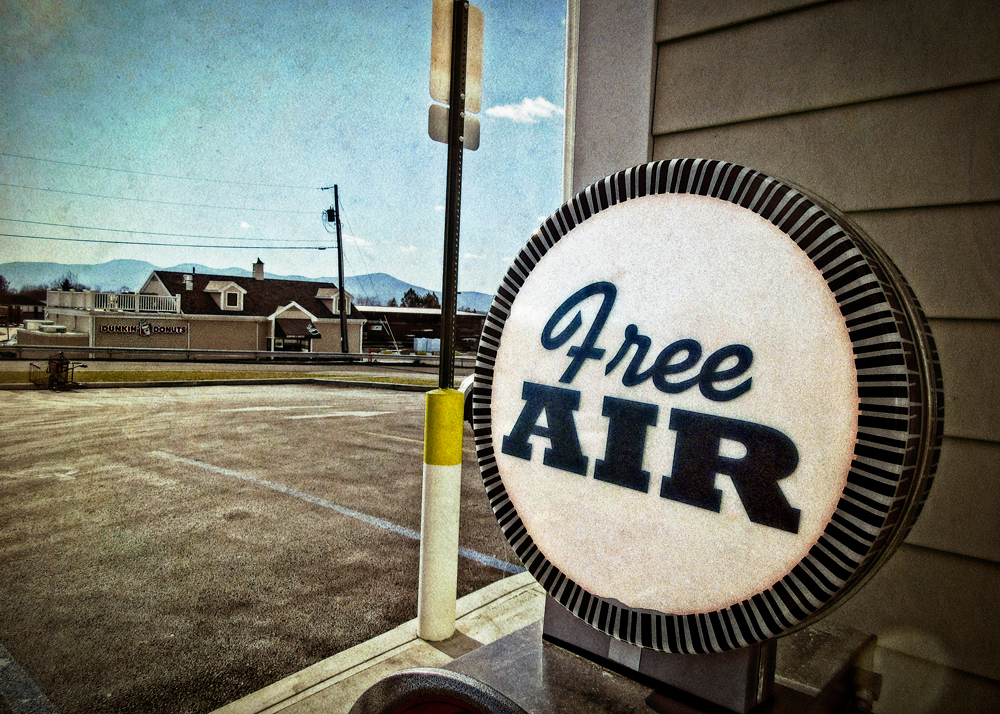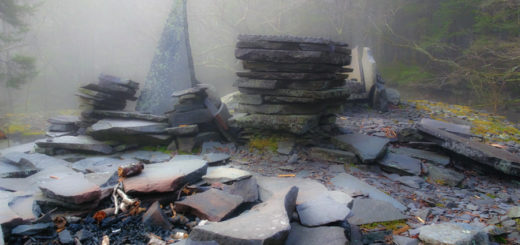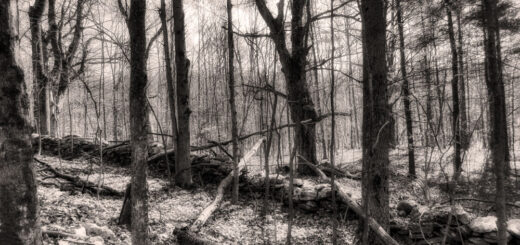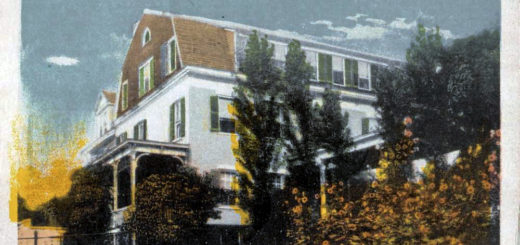Borrowed Scenery
Driving home from the other side of the river, I stopped for gas at a place close by Cedar Grove, the home of Thomas Cole—now a National Historic Landmark—in the village of Catskill. I stood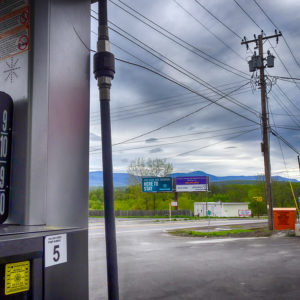 there by the pumps, inhaling noisome filling station fumes and watching the traffic roar by on Route 23. A small television screen installed above the gas nozzles was blaring a commercial for a Caribbean cruise line. Nearby, a trash container was brimming with the scraps of a hundred unhealthy American meals. The ordinary ugliness of the situation was disheartening. I needed something inspiring—so I borrowed a bit scenery. As I looked to the west, there it was, just beyond the filigree of power lines and patchwork of billboards: the Great Wall of Manitou looming under a ceiling of gray clouds. The Catskill Mountains, at that moment, appeared just as the artist Cole—writing not very far from this very spot—described them in his famous 1837 essay on American scenery. The Catskills, he tells us, “have varied, undulating, and exceedingly beautiful outlines—they heave from the valley of the Hudson like the subsiding billows of the ocean after a storm.” Yes, indeed! All at once my gas station blues were assuaged by the blue of the range that in olden days was called Blue.
there by the pumps, inhaling noisome filling station fumes and watching the traffic roar by on Route 23. A small television screen installed above the gas nozzles was blaring a commercial for a Caribbean cruise line. Nearby, a trash container was brimming with the scraps of a hundred unhealthy American meals. The ordinary ugliness of the situation was disheartening. I needed something inspiring—so I borrowed a bit scenery. As I looked to the west, there it was, just beyond the filigree of power lines and patchwork of billboards: the Great Wall of Manitou looming under a ceiling of gray clouds. The Catskill Mountains, at that moment, appeared just as the artist Cole—writing not very far from this very spot—described them in his famous 1837 essay on American scenery. The Catskills, he tells us, “have varied, undulating, and exceedingly beautiful outlines—they heave from the valley of the Hudson like the subsiding billows of the ocean after a storm.” Yes, indeed! All at once my gas station blues were assuaged by the blue of the range that in olden days was called Blue.
“Borrowed scenery” refers to the method of incorporating background landscape into the composition of a garden or a designed landscape such as a park. The term traces back to a 17th century Chinese treatise on garden-making and was adopted by Japanese designers in the 1960s. Shortly after that it came into widespread use among landscape architects in Europe and North America. The idea behind it, however, is much older. Examples of borrowed scenery can be found throughout the history of garden-making in both Eastern and Western traditions. In 1881, for instance, Calvert Vaux—co-designer of Central Park—published a trim and delightful volume called Concerning Lawn Planting, with the stated intention of “advancing the standard of landscape architecture in the United States.” The book opens with a brief essay titled “Sky and Sky Line.” The first sentence expresses the core principle of borrowed scenery: “A man who owns an acre of ground cannot look far without reaching its lateral boundaries, but in the direction of the sky, his acre gives him a wide extent of view that constitutes a valuable property.” And it’s not just the sky that can be borrowed but mountains, rivers, pastures, orchards, and even city skylines. To borrow scenery is akin to what road-makers do when they dig their “borrow pits” during highway construction, only instead of soil or gravel it’s a view that’s being excavated.
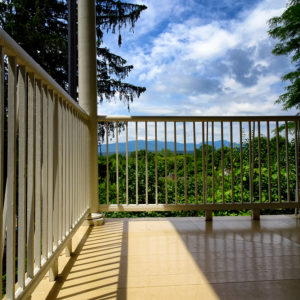 Only a small stretch of borrowed scenery is to be found today at Cedar Grove. You can enjoy it from the porch on the western side of the house. The local utility company has yielded to aesthetic and historic interests by burying a couple hundred feet of electrical and communication lines beneath the ground along Spring Street so as not to disrupt the view of the mountains from the house. Thus the vista that unfolds there today is much the same as what Cole would have enjoyed, except these days dense forest covers most of the landscape and missing are the plumes and clangor of coal-fired railroad engines. Visitors to Cole’s house snap pictures from the porch and express enthusiasm for the “million dollar view.”
Only a small stretch of borrowed scenery is to be found today at Cedar Grove. You can enjoy it from the porch on the western side of the house. The local utility company has yielded to aesthetic and historic interests by burying a couple hundred feet of electrical and communication lines beneath the ground along Spring Street so as not to disrupt the view of the mountains from the house. Thus the vista that unfolds there today is much the same as what Cole would have enjoyed, except these days dense forest covers most of the landscape and missing are the plumes and clangor of coal-fired railroad engines. Visitors to Cole’s house snap pictures from the porch and express enthusiasm for the “million dollar view.”
A more extensive sampling of borrowed scenery is available directly across the river at Olana, the 250 acre estate of Frederic Edwin Church, Cole’s student and fellow landscape artist. Church became the most successful American artist in the 19th century. In his later years he suffered from a form of arthritis that made it painful for him to paint, so he turned—for the most part—from making pictures to designing landscapes. For his “canvas” he chose an overgrazed prominence along the Hudson locally known as the Sienghenberg (Dutch for “long hill”), which he acquired in parcels over the course of several years. In addition to planting thousands of native trees around the barren hillsides, he expanded and enhanced the working farm that already existed on the site. By the mid 1880s, Church had constructed more than five miles of carriage roads leading to a variety of carefully rendered openings that afforded views of the surrounding mountain ranges—the Catskills, Taconics, Shawangunks, and Hudson Highlands—as well as the adjacent Hudson River. In a letter dated October 18, 1884, Church writes: “I have made about 1 ¾ miles of road this season, opening entirely new and beautiful views. I can make more and better landscapes in this way than by tampering with canvas and paint in the studio.”
It would seem that the transition from being a painter of landscapes to one who actually shapes them is a natural one, as both types of artist are responding to the passage of time. What Calvert 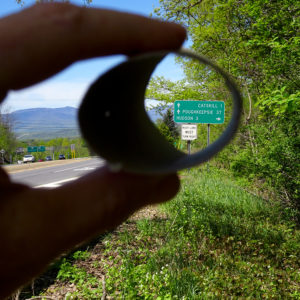 Vaux observes about the painter is equally true of the designer: “The typical landscape painter may be said, indeed, to observe the aspects, rather than the forms of nature. He is fascinated by some effect of light and shade and color, that depends on a particular season of the year, or the sunlight and atmosphere of some special hour of a day . . . and he sees and paints his beautiful picture, which is, in fact, devoted to the illustration of a passing moment of time.” Yet a significant difference emerges between landscape painter and landscape designer: the former attempts to arrest a particular moment within a frame, whereas the latter must work with—and ultimately submit to—the flow of time.
Vaux observes about the painter is equally true of the designer: “The typical landscape painter may be said, indeed, to observe the aspects, rather than the forms of nature. He is fascinated by some effect of light and shade and color, that depends on a particular season of the year, or the sunlight and atmosphere of some special hour of a day . . . and he sees and paints his beautiful picture, which is, in fact, devoted to the illustration of a passing moment of time.” Yet a significant difference emerges between landscape painter and landscape designer: the former attempts to arrest a particular moment within a frame, whereas the latter must work with—and ultimately submit to—the flow of time.
Admittedly, few are the artists as fortunate as Frederic Church, who could afford to buy 250 acres and erect a castle thereon. Lucky for us, this exemplary work of art is now—in its entirety—a New York State Historic Site. After more than a century of neglect, the Olana landscape is now being restored to something along the lines of what Church intended. Of course, it will not be exactly the same as it was in his day—nature never ceases in its changes—but if you ever had the hankering to step into a Hudson River School painting and hike around, here is one place you might do so. Even if you can’t make it to Olana and instead find yourself stranded in a gas station, parking lot, or tollbooth within sight of the Catskill Mountains, the scenery is still available to borrow. And the interest is free.
©John P. O’Grady
Originally appeared in The Mountain Eagle on June 29, 2018
